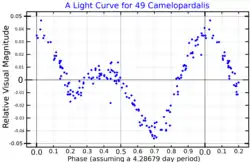49 Camelopardalis
49 Camelopardalis is a variable star in the northern circumpolar constellation of Camelopardalis,[9] located 313 light years from the Sun based on parallax measurements.[2] It has the variable star designation BC Camelopardalis; 49 Camelopardalis is the Flamsteed designation. This star is a challenge to view with the naked eye, having a baseline apparent visual magnitude of 6.50.[3] It is moving away from the Earth with a heliocentric radial velocity of +6.5 km/s.[3]
| Observation data Epoch J2000.0 Equinox J2000.0 | |
|---|---|
| Constellation | Camelopardalis |
| Right ascension | 07h 46m 27.41459s[2] |
| Declination | +62° 49′ 49.8895″[2] |
| Apparent magnitude (V) | 6.50[3] (6.43–6.48)[4] |
| Characteristics | |
| Spectral type | A7VpSrCrEuSiKsn[5] |
| B−V color index | 0.262±0.002[3] |
| Variable type | α2 CVn[4] |
| Astrometry | |
| Radial velocity (Rv) | 6.5±0.5[3] km/s |
| Proper motion (μ) | RA: −36.63[6] mas/yr Dec.: −61.36[6] mas/yr |
| Parallax (π) | 10.4369 ± 0.0566 mas[2] |
| Distance | 313 ± 2 ly (95.8 ± 0.5 pc) |
| Absolute magnitude (MV) | 1.58[3] |
| Details[7] | |
| Mass | 1.92+0.14 −0.25 M☉ |
| Radius | 2.32±0.33 R☉ |
| Luminosity | 17.4+3.5 −2.9 L☉ |
| Surface gravity (log g) | 3.99±0.13 cgs |
| Temperature | 7,740±460 K |
| Metallicity [Fe/H] | −3.40±0.16 dex |
| Rotation | 4.28677±0.00003 d[8] |
| Rotational velocity (v sin i) | 25.8±1.0 km/s |
| Age | 891+489 −316 Myr |
| Other designations | |
| Database references | |
| SIMBAD | data |
This is a magnetic chemically peculiar star[7] with a stellar classification of A7VpSrCrEuSiKsn,[5] indicating it is an A-type main-sequence star with overabundances of various elements including strontium and europium, as well as broad, "nebulous" lines. The magnetic field of 49 Camelopardalis shows a relatively complex structure, in combination with distinct abundance patterns across the surface.[10] It is classified as an Alpha2 Canum Venaticorum type variable and its brightness varies from visual magnitude +6.43 down to +6.48 with a rotationally-modulated period of 4.29 days.[4]
49 Camelopardalis has 1.9 times the mass of the Sun and 2.3 times the Sun's radius. It is around 891[7] million years old and is spinning with a period of 4.29 days.[8] The star is radiating 17 times the luminosity of the Sun from its photosphere at an effective temperature of 7,740 K.[7]
References
- Adelman, S. J.; Kaewkornmaung, P. (June 2005). "uubyFCAPT photometry of the mCP stars HD 32633, θ Aur, 49 Cam, and 3 Hya". Astronomy and Astrophysics. 435 (3): 1099–1104. Bibcode:2005A&A...435.1099A. doi:10.1051/0004-6361:20042628.
- Brown, A. G. A.; et al. (Gaia collaboration) (August 2018). "Gaia Data Release 2: Summary of the contents and survey properties". Astronomy & Astrophysics. 616. A1. arXiv:1804.09365. Bibcode:2018A&A...616A...1G. doi:10.1051/0004-6361/201833051. Gaia DR2 record for this source at VizieR.
- Anderson, E.; Francis, Ch. (2012), "XHIP: An extended hipparcos compilation", Astronomy Letters, 38 (5): 331, arXiv:1108.4971, Bibcode:2012AstL...38..331A, doi:10.1134/S1063773712050015, S2CID 119257644.
- Samus, N. N.; et al. (2017), "General Catalogue of Variable Stars", Astronomy Reports, 5.1, 61 (1): 80–88, Bibcode:2017ARep...61...80S, doi:10.1134/S1063772917010085, S2CID 125853869.
- Abt, Helmut A.; Morrell, Nidia I. (1995), "The Relation between Rotational Velocities and Spectral Peculiarities among A-Type Stars", Astrophysical Journal Supplement Series, 99: 135, Bibcode:1995ApJS...99..135A, doi:10.1086/192182.
- van Leeuwen, F. (2007), "Validation of the new Hipparcos reduction", Astronomy and Astrophysics, 474 (2): 653–664, arXiv:0708.1752, Bibcode:2007A&A...474..653V, doi:10.1051/0004-6361:20078357, S2CID 18759600.
- Sikora, J.; et al. (February 2019), "A Volume-Limited Survey of mCP Stars Within 100pc I: Fundamental Parameters and Chemical Abundances", Monthly Notices of the Royal Astronomical Society, 483 (2): 2300–2324, arXiv:1811.05633, Bibcode:2019MNRAS.483.2300S, doi:10.1093/mnras/sty3105, S2CID 119089236.
- Sikora, J.; et al. (March 2019), "A volume-limited survey of mCP stars within 100 pc II: rotational and magnetic properties", Monthly Notices of the Royal Astronomical Society, 483 (3): 3127–3145, arXiv:1811.05635, Bibcode:2019MNRAS.483.3127S, doi:10.1093/mnras/sty2895, S2CID 119415579.
- "49 Cam". SIMBAD. Centre de données astronomiques de Strasbourg. Retrieved 2019-04-22.
- Silvester, J.; et al. (October 2017), "The complex magnetic field topology of the cool Ap star 49 Cam", Monthly Notices of the Royal Astronomical Society, 471 (1): 962–975, arXiv:1706.09196, Bibcode:2017MNRAS.471..962S, doi:10.1093/mnras/stx1606, S2CID 54694617.
